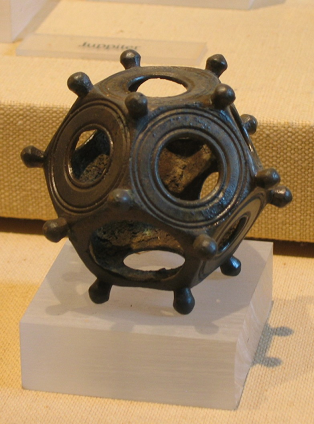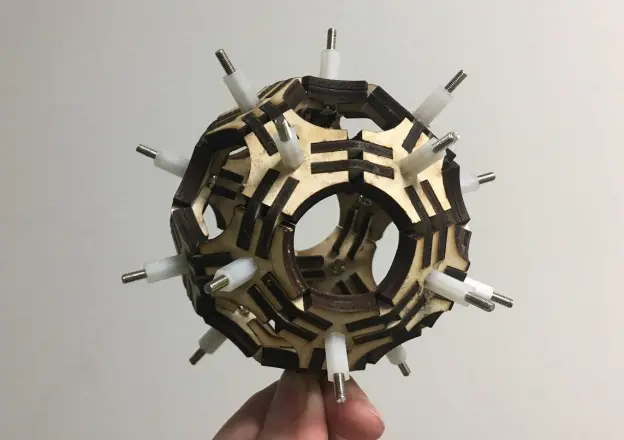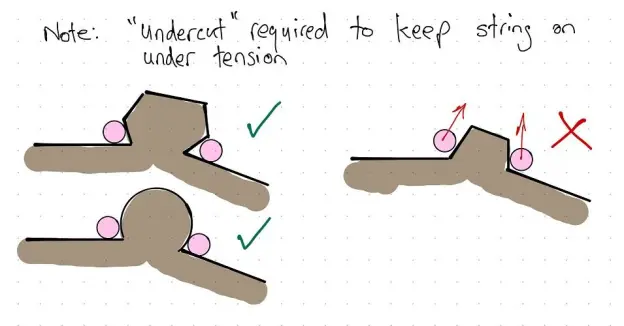I recently came across these fascinating old Roman artefacts:
https://en.wikipedia.org/wiki/Roman_dodecahedron

Several hundred of them have been found, all around Europe, and what the purpose of them is is considered a mystery.
Some things to note about the dodecahedra:
- They all appear to have ‘nodules’ on the vertices.
- The hole sizes are not consistent
- The size of the objects aren’t consistent
I decided to make my own model, and after playing with it for a while, I believe I’ve (re-re-)discovered what they were used for.

But first, I want to go over some ideas that are mentioned in the literature.
About the ‘rangefinder’ idea:
Several people have proposed that the dodecahedra were rangefinders, used for positioning something at a preset distance. Often this idea is accompanied by a diagram showing how to look through the holes at a distant Roman army staff as a reference, and position yourself accordingly. The implication being that up and down the front lines commanders would use these to ensure they were spread out appropriately.
I really, really have to object to that. That explanation just doesn’t work, and here’s why: If you were giving someone a rangefinder, to be used in the heat of (or just prior to) battle, you’d want to make it completely idiot proof.
What I mean is, when designing let’s say, ‘tactical devices’, they need to be able to be used in a hurry and when the operator is completely distracted. The correct way to use the device should be absolutely obvious, and any incorrect ways to use it must be so obviously wrong that they it becomes unlikely to be attempted. The dodecahedron fails on all these points. There are 12 different ways to look through it, only six of which are correct, and five of those six will still be the wrong setting for what you actually want to do.
Furthermore, there doesn’t appear to be any engravings or text to indicate what the different holes mean. If it were a tactical rangefinder, you’d expect something like [“5 stadia”, “2 stadia”, etc] to be really, really clearly marked on it, so you didn’t get confused or make a mistake in the heat of battle. Yes, there are slightly different concentric circle designs on the faces, but that is a really subtle code, (or more likely, an aesthetic flourish on the part of the artist) and not the sort of thing you’d want to rely on deciphering properly when stressed, such as when you knew there was going to be a lot of stabbing and bleeding happening in the near future..
And I want to point out that the Romans weren’t exactly strangers to combat. They were really good at thinking of the practicalities of warfare, had a ton of experience, and made a habit of equipping their soldiers with sensible and useful things. I don’t see them handing out a device like this for tactical use.
About the surveying tool idea:
It’s also suggested that the dodecahedra were surveying tools, used for working out angles between things, and laying down plans. I don’t really find this compelling, for two reasons:
- One: if you wanted to make a protractor or similar device, you could do so much more directly. It would also allow you to measure any angle, or see how much error was in your measured angle, rather than only measure certain pre-set values. And it would use substantially less metal than the dodecahedron.
- Two: the Romans were kinda fond of Cartesian designs. Check out their blueprints for how to set up an army camp. It’s rows and columns and 90 degree angles all the way. Guess what you can’t find on the dodecahedrons, no matter how you turn it? Exactly. There are no right angles. To try and use the angles present on the dodecahedron as a surveying tool would be irrational (heh).
The ‘Nodules’ are super important:
All the photos I’ve seen of Roman dodecahedrons show them having ‘nodules’ at the vertices.
They appear to be brazed onto the dodecahedrons at a later stage after the body was made. In other words, it added a step to manufacturing, and hence increased the cost and complexity of the device.
When a device is made across a large area and by many people, I don’t think it’s conceivable that any feature would be so consistently reproduced, unless it was an intrinsic and necessary part of the device’s function. In other words, people are both lazy and full of their own ideas. If the nodules were ‘vestigial’, then sooner or later someone would just make a dodecahedron without them, and save money and time.
I might be wrong on this, but nodules are present on all the pictures of dodecahedrons I’ve seen, and as far as I’m aware there weren’t any varieties of Roman dodecahedrons that were constructed without them present. There is, however, at least one Roman icosahedron that has the nodules present, but omits the holes in the face!
It’s not for grip:
I’ve seen proposals that the nodules were meant as aids to grip the dodecahedron, perhaps while using gloves. I find this a bit hard to believe, for the simple reason that dodecahedrons are constructed exclusively of pairs of flat, opposing sides. In other words no matter which angle you pick it up from, your fingers will intuitively find a pair of places to ‘pincer’ which perfectly balance the forces. (Compare that with trying to pick up something like a pyramid shape, which actually would be tricky, since you’d be forced to grip one pointy vertex, and one flat face.)
Even wearing gloves, it’s not hard at all to manipulate a dodecahedron. Certainly not to the point where you’d order the craftsman to carefully solder twenty balls to it, rather than just one ‘lollipop’ style handle, or some other method for holding it.
[Screw it. I just went and tested adding a lollipop style handle to my dodecahedron model. With a handle, you can easily hold it and swivel it to look through six of the twelve holes in a matter of seconds, without blocking the view with your hand. For a viewfinder, a handle is far more convenient than manipulating a spherical object directly, or adding 20 balls]
The nodules are not precisely calibrated:
Assuming it’s a surveying, astronomical or calendar device, then if you wanted to measure an angle in relation to a flat surface (such as putting it on a flat table and measuring the Sun’s position above the horizon), you’d need to make sure that the nodules it rested on were calibrated to the angle you wanted to measure. Casting or brazing bronze is not going to give you ‘Astronomical’ levels of precision right off the bat, there would need to be a calibration step involved.
In other words, when making the dodecahedron, you’d:
- First build the rough shape of the device by casting and/or brazing the parts together,
- Then measure the angle it made, and how much error was present,
- Then carefully file down the parts of the feet contacting the floor, stopping to measure it occasionally, until it was perfectly tuned.
The photos of dodecahedrons I’ve seen don’t show any sign of having been filed down or ‘tuned’. Filing would have been necessary, rather than just bending the nodules apart, since bending one nodule affects the calibration of not one, but three other holes.
Both the Romans and Greeks were no strangers to precision craftsmanship, and could easily have made devices much more precise than these dodecahedra with little effort. (I mean c’mon! The Antikythera mechanism is actually older than these toys).
Observation: All the nodules are undercut, which is perfect for gripping string:
What is super interesting about the nodules is that they all have a spherical or an undercut shape.
To my mind, that immediately suggests that they were used in combination with string or cord of some sort, since if they were present just for added grip that wouldn’t be needed (and indeed, would just make it more likely to get snagged on things)

Also, this notion of the ‘undercut’ nodule being a functional requirement is consistent
with all the dodecahedra I’ve seen. Even these super unusual ones that has triangular holes:
http://www.la-detection.com/dp/message-75691.htm
Or these miniscule gold dodecahedra from Thailand and Burma:
https://journals.openedition.org/archeosciences/2072
Although these gold polyhedra are positively tiny (and possibly just intended to be decorative versions of the larger ones), the shape of the nodules is still clearly undercut, and it’s easy to imagine winding a small thread around them.
Back to the Roman dodecahedrons. Looking closer, although string or twine definitely seems to be involved, it doesn’t appear to be a primarily ‘practical’ object. In particular:
- Using it as a ‘Knitting Nancy’ https://en.wikipedia.org/wiki/Spool_knitting doesn’t seem like a good explanation. Each hole has 5 pegs, so you’d get the same result no matter which orientation you used. It’d be far easier to carry something that wasn’t so bulky and redundant if you wanted to knit that way.
- Using it as a yarn holder, or ‘NItty Noddy’ doesn’t make sense either. https://en.wikipedia.org/wiki/Niddy_noddy
- Your wool would be trapped on there,
- there’s more than one way to wind it, which is confusing,
- And it doesn’t actually hold much string anyway.
There would be far better ways to do the same task without involving platonic solids.
- You could maybe make an argument that it’s a drop spindle, https://en.wikipedia.org/wiki/Spindle_(textiles) but you can do that for pretty much any object. So I don’t consider that sufficient to explain why it was recreated so prolifically and with the same conserved feature set (dodecahedral shape, nodules on every vertex).
As a next step, I started thinking about the kinds of games you could play with string and a dodecahedron.
Continued in part II.
[Edit 2020/06/17 – Added link to dodecahedra with triangular holes]

Pingback: Roman Dodecahedrons Part II | Tinkerings
You were so close when you mentioned that even wearing gloves, it was easy to manipulate the dodecahedron. Please look up using these devices for knitting gloves. Different sized holes based on sizes for fingers from adult male thumbs to children’s pinkies. No religious ties. No need to invent a new calendar. Absolutely practical.
LikeLike
Hi Aric,
I did consider that, but it’s just not a practical solution, sorry. For one thing a “knitting nancy” doesn’t determine the size of a finger glove based on its hole diameter, it is based on the number of pegs the yarn is wound around. And dodecahedrons always have 5 pegs per hole, so there’d be no difference for the fingers. Also, you end up with a ridiculously impractical weave with only 5, and all the modern recreations of gloves using dodecahedra are clunky and have huge holes compared to other textile stuff of the era. For a contemporary example of the fabricwork available at the time, check out “nalbinding”, and the “Egyptian sock” in particular. https://www.smithsonianmag.com/smartnews-history-archaeology/1700-year-old-sock-spins-yarn-about-ancient-egyptian-fashion-180970501/
They’re far more warm and practical than anything you could make with a dodecahedron.
I’ve checked this idea with several people in the SCA who are into the history of textile stuff, and they agree that the knitting idea is impractical.
The dodecahedron is so popular that many people, spready across large swathes of Europe and a couple of centuries apparently considered having one to be worth paying the large expense of a craftsman’s labour to construct and cast it out of bronze. So it’s function needs to be really optimal to explain the popularity. To my mind a portable “travel-proof” calendar fits that nicely, but a suboptimal glove making tool doesn’t.
Cheers,
Gavin
LikeLike
Pingback: Fiber arts, mysterious dodecahedrons, and waiting on “Eureka!” | Eukaryote Writes Blog